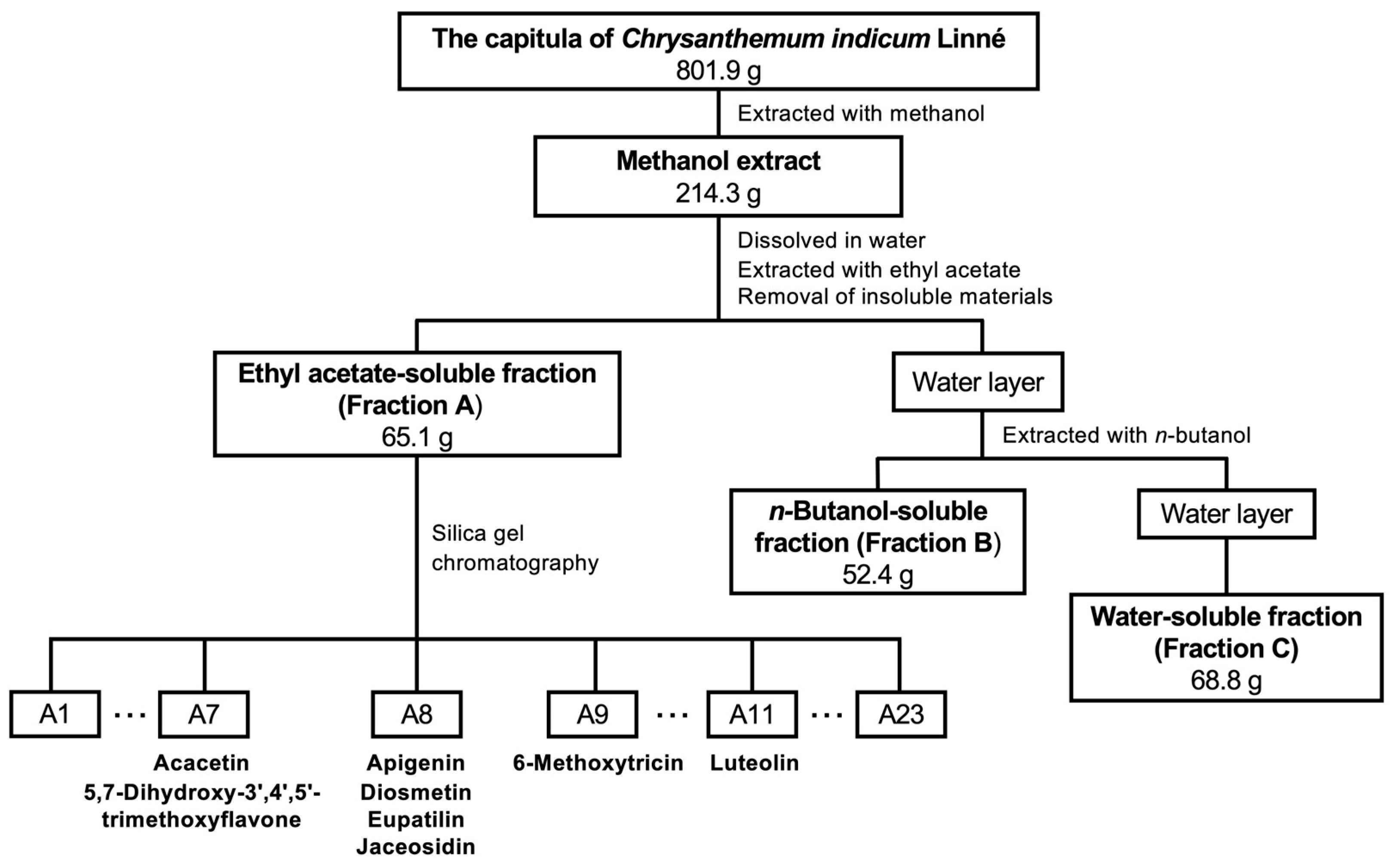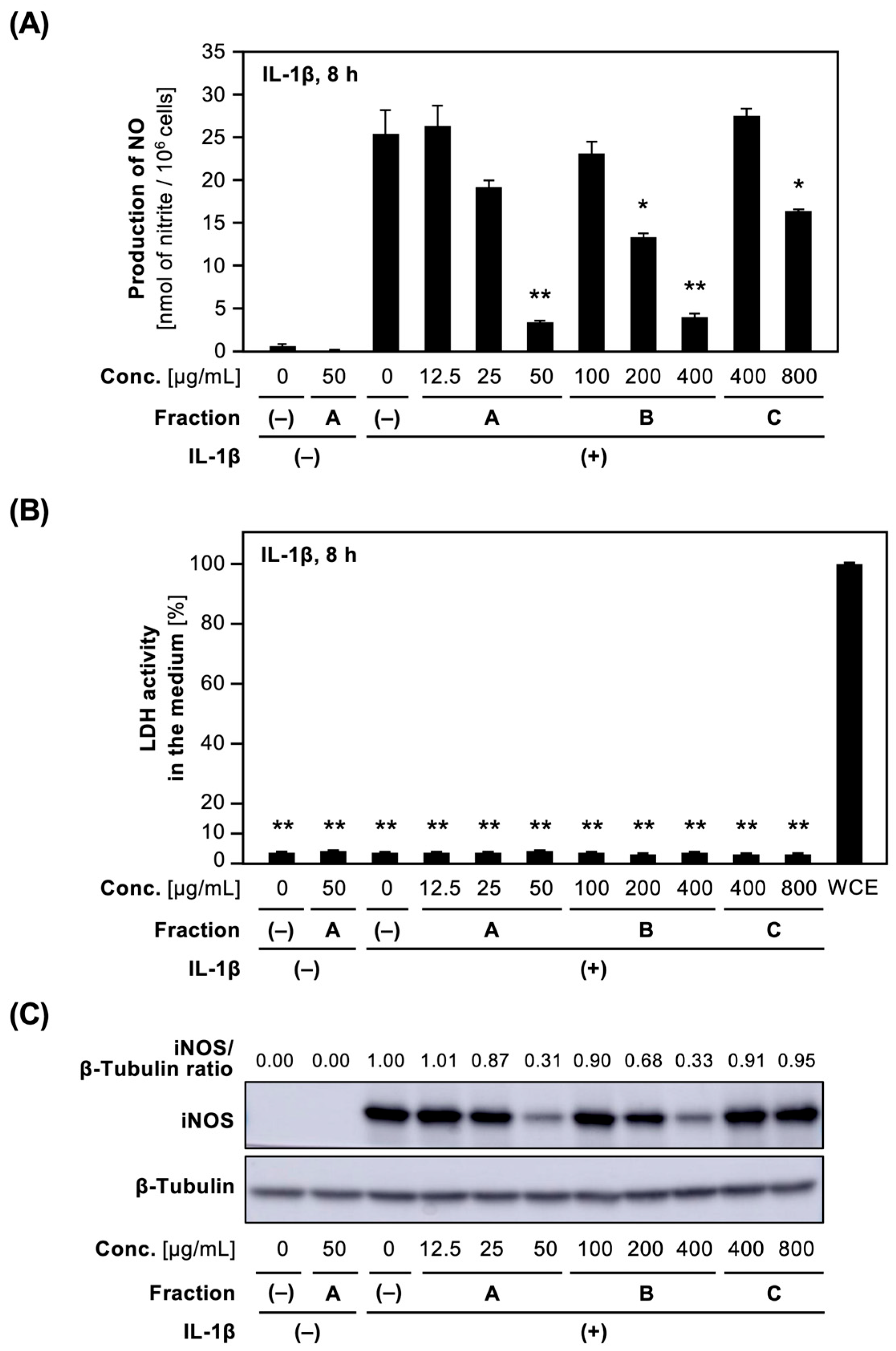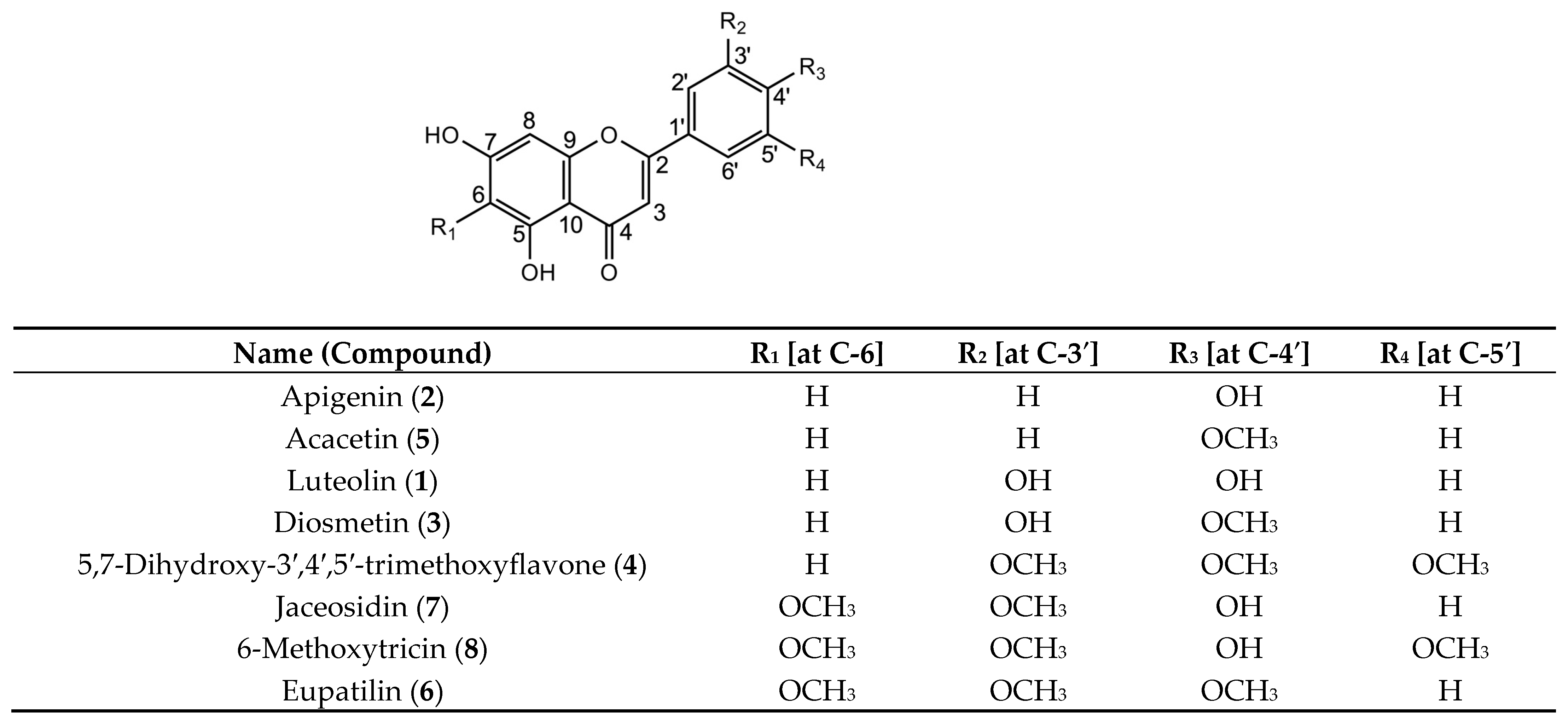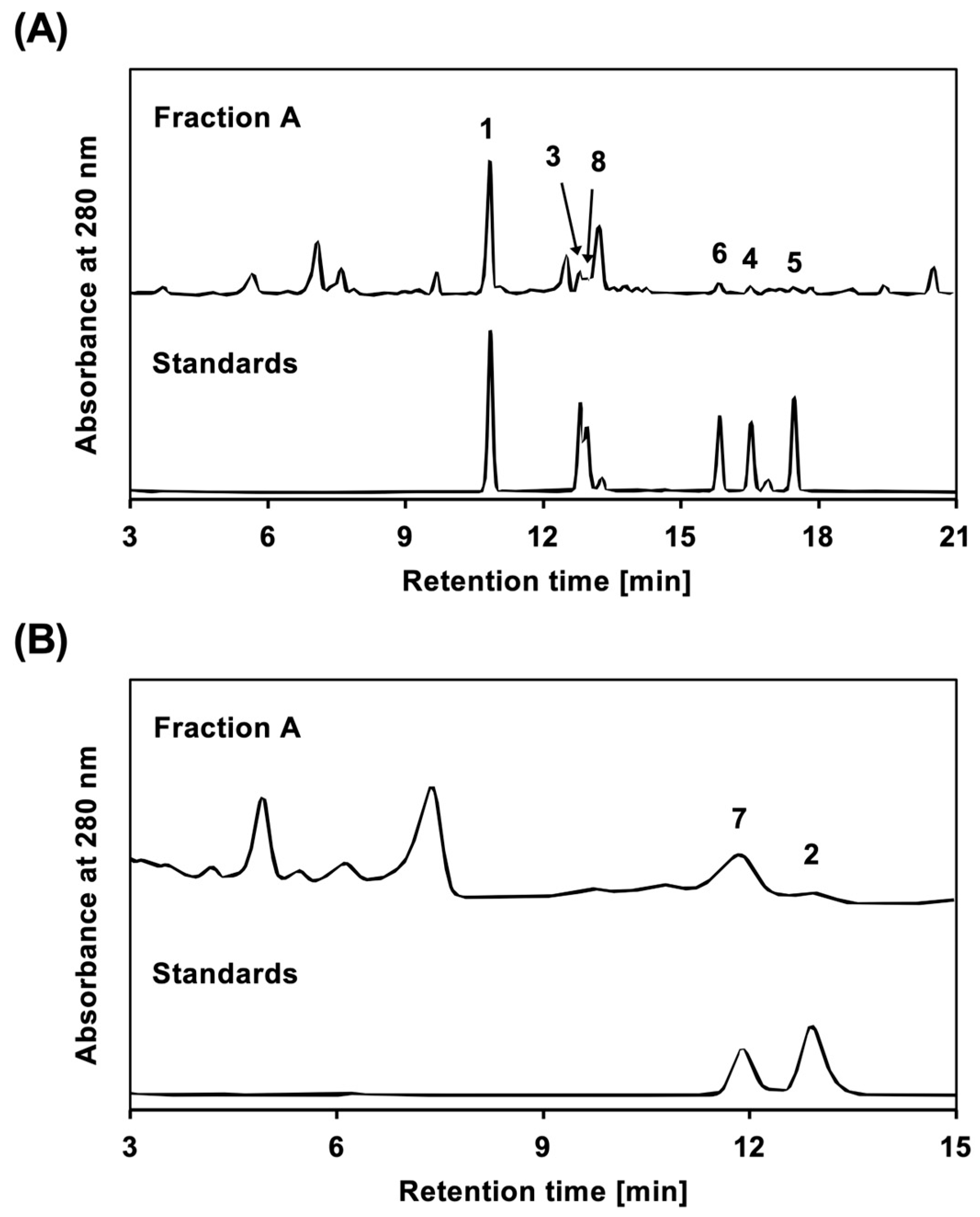Comparative Analysis of Anti-Inflammatory Flavones in Chrysanthemum indicum Capitula Using Primary Cultured Rat Hepatocytes
Abstract
1. Introduction
2. Results
2.1. Extraction of C. indicum Capitula
2.2. Identification of Compounds in Fraction A from C. indicum Capitulum (CIC) Extract
2.3. Flavone Content in Fraction A of the CIC Extract
2.4. Effects of CIC Flavones on NO Production in IL-1β-Treated Hepatocytes
2.5. Effects of CIC Flavones on the Expression of the iNOS mRNA in Hepatocytes
2.6. Effects of CIC Flavones on Proinflammatory Gene Expression in Hepatocytes
3. Discussion
4. Materials and Methods
4.1. General Experimental Procedures
4.2. Plant Material
4.3. Extraction and Fractionation of the Methanol Extract
4.4. Isolation of the Compounds from CIC Extract
4.5. Measuring Compound Content Using HPLC
4.6. Animals and Primary Cultured Rat Hepatocytes
4.7. NO Assay and LDH Activity
4.8. Western Blot Analysis and Densitometry
4.9. RT–qPCR
4.10. Statistical Analysis
5. Conclusions
Author Contributions
Funding
Institutional Review Board Statement
Informed Consent Statement
Data Availability Statement
Acknowledgments
Conflicts of Interest
References
- The Committee on the Japanese Pharmacopoeia. Crude Drugs and Related Drugs. In The Japanese Pharmacopoeia, 18th ed.; The Ministry of Health, Labour and Welfare: Tokyo, Japan, 2021. Available online: https://www.mhlw.go.jp/content/11120000/001372350.pdf (accessed on 14 February 2025).
- Kitagawa, I.; Kuwashima, H.; Shoji, J.; Tomoda, S.; Nohara, T.; Kinjo, J.; Sankawa, U.; Takido, M.; Nishioka, I.; Yamagishi, T. Shoyakugaku (Pharmacognosy), 9th ed.; Hirokawa Shoten Co.: Tokyo, Japan, 2017; pp. 296–299. [Google Scholar]
- Shao, Y.; Sun, Y.; Li, D.; Chen, Y. Chrysanthemum indicum L.: A Comprehensive Review of its Botany, Phytochemistry and Pharmacology. Am. J. Chin. Med. 2020, 48, 871–897. [Google Scholar] [CrossRef]
- Yoshikawa, M.; Morikawa, T.; Murakami, T.; Toguchida, I.; Harima, S.; Matsuda, H. Medicinal flowers. I. Aldose reductase inhibitors and three new eudesmane-type sesquiterpenes, kikkanols A, B, and C, from the flowers of Chrysanthemum indicum L. Chem. Pharm. Bull. 1999, 47, 340–345. [Google Scholar] [CrossRef]
- Yoshikawa, M.; Morikawa, T.; Toguchida, I.; Harima, S.; Matsuda, H. Medicinal flowers. II. Inhibitors of nitric oxide production and absolute stereostructures of five new germacrane-type sesquiterpenes, kikkanols D, D monoacetate, E, F, and F monoacetate from the flowers of Chrysanthemum indicum L. Chem. Pharm. Bull. 2000, 48, 651–656. [Google Scholar] [CrossRef]
- Tian, D.; Yang, Y.; Yu, M.; Han, Z.Z.; Wei, M.; Zhang, H.W.; Jia, H.M.; Zou, Z.M. Anti-inflammatory chemical constituents of Flos Chrysanthemi indici determined by UPLC-MS/MS integrated with network pharmacology. Food Funct. 2020, 11, 6340–6351. [Google Scholar] [CrossRef]
- Singh, M.; Kaur, M.; Silakari, O. Flavones: An important scaffold for medicinal chemistry. Eur. J. Med. Chem. 2014, 84, 206–239. [Google Scholar] [CrossRef]
- Chagas, M.D.S.S.; Behrens, M.D.; Moragas-Tellis, C.J.; Penedo, G.X.M.; Silva, A.R.; Gonçalves-de-Albuquerque, C.F. Flavonols and Flavones as Potential anti-inflammatory, Antioxidant, and Antibacterial Compounds. Oxid. Med. Cell. Longev. 2022, 2022, 9966750. [Google Scholar] [CrossRef] [PubMed]
- Lee, D.H.; Park, J.K.; Choi, J.; Jang, H.; Seol, J.W. Anti-inflammatory effects of natural flavonoid diosmetin in IL-4 and LPS-induced macrophage activation and atopic dermatitis model. Int. Immunopharmacol. 2020, 89, 107046. [Google Scholar] [CrossRef] [PubMed]
- Sun, L.C.; Zhang, H.B.; Gu, C.D.; Guo, S.D.; Li, G.; Lian, R.; Yao, Y.; Zhang, G.Q. Protective effect of acacetin on sepsis-induced acute lung injury via its anti-inflammatory and antioxidative activity. Arch. Pharm. Res. 2018, 41, 1199–1210. [Google Scholar] [CrossRef]
- Yoshigai, E.; Hara, T.; Inaba, H.; Hashimoto, I.; Tanaka, Y.; Kaibori, M.; Kimura, T.; Okumura, T.; Kwon, A.; Nishizawa, M. Interleukin-1β induces tumor necrosis factor-α secretion from rat hepatocytes. Hepatol. Res. 2014, 44, 571–583. [Google Scholar] [CrossRef] [PubMed]
- Kitade, H.; Sakitani, K.; Inoue, K.; Masu, Y.; Kawada, N.; Hiramatsu, Y.; Kamiyama, Y.; Okumura, T.; Ito, S. Interleukin 1 beta markedly stimulates nitric oxide formation in the absence of other cytokines or lipopolysaccharide in primary cultured rat hepatocytes but not in Kupffer cells. Hepatology 1996, 23, 797–802. [Google Scholar] [CrossRef]
- Matsui, K.; Nishizawa, M.; Ozaki, T.; Kimura, T.; Hashimoto, I.; Yamada, M.; Kaibori, M.; Kamiyama, Y.; Ito, S.; Okumura, T. Natural antisense transcript stabilizes inducible nitric oxide synthase messenger RNA in rat hepatocytes. Hepatology 2008, 47, 686–697. [Google Scholar] [CrossRef] [PubMed]
- Nakajima, A.; Yamamoto, Y.; Yoshinaka, N.; Namba, M.; Matsuo, H.; Okuyama, T.; Yoshigai, E.; Okumura, T.; Nishizawa, M.; Ikeya, Y. A new flavanone and other flavonoids from green perilla leaf extract inhibit nitric oxide production in interleukin 1β-treated hepatocytes. Biosci. Biotechnol. Biochem. 2015, 79, 138–146. [Google Scholar] [CrossRef] [PubMed]
- Colasanti, M.; Suzuki, H. The dual personality of NO. Trends Pharmacol. Sci. 2000, 21, 249–252. [Google Scholar] [CrossRef] [PubMed]
- Aziz, N.; Kim, M.Y.; Cho, J.Y. Anti-inflammatory effects of luteolin: A review of in vitro, in vivo, and in silico studies. J. Ethnopharmacol. 2018, 225, 342–358. [Google Scholar] [CrossRef]
- Al-Megrin, W.A.; Alkhuriji, A.F.; Yousef, A.O.S.; Metwally, D.M.; Habotta, O.A.; Kassab, R.B.; Abdel Moneim, A.E.; El-Khadragy, M.F. Antagonistic Efficacy of Luteolin against Lead Acetate Exposure-Associated with Hepatotoxicity is Mediated via Antioxidant, Anti-Inflammatory, and Anti-Apoptotic Activities. Antioxidants 2020, 9, 10. [Google Scholar] [CrossRef]
- Jia, Z.; Nallasamy, P.; Liu, D.; Shah, H.; Li, J.Z.; Chitrakar, R.; Si, H.; McCormick, J.; Zhu, H.; Zhen, W.; et al. Luteolin protects against vascular inflammation in mice and TNF-alpha-induced monocyte adhesion to endothelial cells via suppressing IΚBα/NF-κB signaling pathway. J. Nutr. Biochem. 2015, 26, 293–302. [Google Scholar] [CrossRef]
- Yamada, M.; Nishizawa, M.; Nakatake, R.; Habara, K.; Yoshida, H.; Ozaki, T.; Matsui, K.; Hamada, Y.; Kamiyama, Y.; Ito, S.; et al. Characterization of alternatively spliced isoforms of the type I interleukin-1 receptor on iNOS induction in rat hepatocytes. Nitric Oxide 2007, 17, 98–105. [Google Scholar] [CrossRef]
- Ohno, N.; Yoshigai, E.; Okuyama, T.; Yamamoto, Y.; Okumura, T.; Sato, K.; Ikeya, Y.; Nishizawa, M. Chlorogenic acid from the Japanese herbal medicine Kinginka (Flos Lonicerae japonicae) suppresses the expression of inducible nitric oxide synthase in rat hepatocytes. HOAJ Biol. 2012, 1, 2. [Google Scholar] [CrossRef]
- Ozaki, H.; Nishidono, Y.; Fujii, A.; Okuyama, T.; Nakamura, K.; Maesako, T.; Shirako, S.; Nakatake, R.; Tanaka, K.; Ikeya, Y.; et al. Identification of Anti-Inflammatory Compounds from Peucedanum praeruptorum Roots by Using Nitric Oxide-Producing Rat Hepatocytes Stimulated by Interleukin 1β. Molecules 2023, 28, 5076. [Google Scholar] [CrossRef]
- Cuong, D.T.D.; Dat, H.T.; Duan, N.T.; Thuong, P.D.; Phat, N.T.; Tri, M.D.; Van Son, D.; Hoa, N.T.; Tuyen, P.N.K.; Phung, N.K.P. Isolation and Characterization of Six Flavonoids from the Leaves of Sterculia foetida Linn. Vietnam J. Chem. 2019, 57, 438–442. [Google Scholar] [CrossRef]
- Stefanakis, M.K.; Tsiftsoglou, O.S.; Mašković, P.Z.; Lazari, D.; Katerinopoulos, H.E. Chemical Constituents and Anticancer Activities of the Extracts from Phlomis × commixta Rech. f. (P. cretica × P. lanata). Int. J. Mol. Sci. 2024, 25, 816. [Google Scholar] [CrossRef] [PubMed]
- Zhao, Y.; Cai, L.; Sui, Q.; Lin, F.; Jiang, W.; Chen, J.; Lu, W.; Gao, Q. Facile Synthesis of Acacetin and Its Derivatives. Bioorg. Med. Chem. Lett. 2016, 26, 3577–3580. [Google Scholar] [CrossRef] [PubMed]
- Zhang, W.; Xue, W.; Jia, Y.; Wen, G.; Lian, X.; Shen, J.; Liu, A.; Wu, S. A Concise Synthesis of (±)-7-O-Galloyltricetiflavan. RSC Adv. 2018, 8, 14389–14392. [Google Scholar] [CrossRef] [PubMed]
- Reinhardt, J.K.; Klemd, A.M.; Danton, O.; De Mieri, M.; Smieško, M.; Huber, R.; Bürgi, T.; Gründemann, C.; Hamburger, M. Sesquiterpene Lactones from Artemisia argyi: Absolute Configuration and Immunosuppressant Activity. J. Nat. Prod. 2019, 82, 1424–1433. [Google Scholar] [CrossRef]
- Lee, Y.K.; Hong, E.Y.; Whang, W.K. Inhibitory Effect of Chemical Constituents Isolated from Artemisia iwayomogi on Polyol Pathway and Simultaneous Quantification of Major Bioactive Compounds. BioMed Res. Int. 2017, 2017, 7375615. [Google Scholar] [CrossRef]
- Keefe, P.; Puthanveetil, P. Compare and Contrast of the Cellular Actions of Related Flavonoids, Apigenin and Chrysin. Nutrients 2024, 16, 4195. [Google Scholar] [CrossRef]
- Gehrke, N.; Hövelmeyer, N.; Waisman, A.; Straub, B.K.; Weinmann-Menke, J.; Wörns, M.A.; Galle, P.R.; Schattenberg, J.M. Hepatocyte-specific deletion of IL1-RI attenuates liver injury by blocking IL-1 driven autoinflammation. J. Hepatol. 2018, 68, 986–995. [Google Scholar] [CrossRef]
- Zhukova, J.V.; Lopatnikova, J.A.; Alshevskaya, A.A.; Sennikov, S.V. Molecular mechanisms of regulation of IL-1 and its receptors. Cytokine Growth Factor Rev. 2024, 80, 59–71. [Google Scholar] [CrossRef]
- Singh, V.; Shri, R.; Sood, P.; Singh, M.; Singh, T.G.; Singh, R.; Kumar, A.; Ahmad, S.F. 5,7-Dihydroxy-3′,4′,5′-trimethoxyflavone mitigates lead induced neurotoxicity in rats via its chelating, antioxidant, anti-inflammatory and monoaminergic properties. Food Chem. Toxicol. 2024, 189, 114747. [Google Scholar] [CrossRef]
- Choi, E.J.; Lee, S.; Chae, J.R.; Lee, H.S.; Ju, C.D.; Kim, S.H. Eupatilin inhibits lipopolysaccharide-induced expression of inflammatory mediators in macrophages. Life Sci. 2011, 88, 1121–1126. [Google Scholar] [CrossRef]
- Kim, M.J.; Han, J.M.; Jin, Y.Y.; Baek, N.I.; Bang, M.H.; Chung, H.G.; Choi, M.S.; Lee, K.T.; Sok, D.E.; Jeong, T.S. In vitro antioxidant and anti-inflammatory activities of Jaceosidin from Artemisia princeps Pampanini cv. Sajabal. Arch. Pharm. Res. 2008, 31, 429–437. [Google Scholar] [CrossRef]
- Yin, Y.; Gong, F.Y.; Wu, X.X.; Sun, Y.; Li, Y.H.; Chen, T.; Xu, Q. Anti-inflammatory and immunosuppressive effect of flavones isolated from Artemisia vestita. J. Ethnopharmacol. 2008, 120, 1–6. [Google Scholar] [CrossRef]
- Matsuda, H.; Morikawa, T.; Ando, S.; Toguchida, I.; Yoshikawa, M. Structural requirements of flavonoids for nitric oxide production inhibitory activity and mechanism of action. Bioorg. Med. Chem. 2003, 11, 1995–2000. [Google Scholar] [CrossRef]
- Liao, H.; Ye, J.; Gao, L.; Liu, Y. The main bioactive compounds of Scutellaria baicalensis Georgi. for alleviation of inflammatory cytokines: A comprehensive review. Biomed. Pharmacother. 2021, 133, 110917. [Google Scholar] [CrossRef]
- Akram, M.; Syed, A.S.; Kim, K.A.; Lee, J.S.; Chang, S.Y.; Kim, C.Y.; Bae, O.N. Heme oxygenase 1-mediated novel anti-inflammatory activities of Salvia plebeia and its active components. J. Ethnopharmacol. 2015, 174, 322–330. [Google Scholar] [CrossRef] [PubMed]
- Matsumoto, K.; Zhao, Q.; Niu, Y.; Fujiwara, H.; Tanaka, K.; Sasaki-Hamada, S.; Oka, J. Kampo Formulations, Chotosan, and Yokukansan, for Dementia Therapy: Existing Clinical and Preclinical Evidence. J. Pharmacol. Sci. 2013, 122, 257–269. [Google Scholar] [CrossRef] [PubMed]
- Green, L.C.; Wagner, D.A.; Glogowski, J.; Skipper, P.L.; Wishnok, J.S.; Tannenbaum, S.R. Analysis of nitrate, and [15N]nitrate in biological fluids. Anal. Biochem. 1982, 126, 131–138. [Google Scholar] [CrossRef] [PubMed]
- Inaba, H.; Yoshigai, E.; Okuyama, T.; Murakoshi, M.; Sugiyama, K.; Nishino, H.; Nishizawa, M. Antipyretic analgesic drugs have different mechanisms for regulation of the expression of inducible nitric oxide synthase in hepatocytes and macrophages. Nitric Oxide 2015, 44, 61–70. [Google Scholar] [CrossRef]






| Extract/Crude Fraction | Yield [%] 1 | IC50 [µg/mL] 2 |
|---|---|---|
| Methanol extract | 100 | 75.6 ± 11.9 |
| Fraction A (EtOAc-soluble) | 31.5 | 32.8 ± 3.09 |
| Fraction B (n-butanol-soluble) | 17.1 | 210 ± 22.2 |
| Fraction C (water-soluble) | 51.4 | NA |
| Name (Compound) | Content in the CIC Fraction A [%] 1 | IC50 [µM] 2 | Content/IC50 Ratio | Content/IC50 [%] 3 |
|---|---|---|---|---|
| Chrysin (5,7-dihydroxyflavone) | ND | 11.6 ± 0.56 | ––– | ––– |
| Apigenin (2) | 0.13 | 12 ± 5.4 4 | 0.007 | 26.9 |
| Acacetin (5) | 0.16 | 14.6 ± 1.73 | 0.011 | 41.9 |
| Luteolin (1) | 0.80 | 39 ± 7.4 4 | 0.026 | 100 |
| Diosmetin (3) | 0.31 | 19.7 ± 1.73 | 0.016 | 60.2 |
| 5,7-Dihydroxy-3′,4′,5′-trimethoxyflavone (4) | 0.27 | 30.4 ± 5.20 | 0.009 | 34.0 |
| Jaceosidin (7) | 0.77 | 43.5 ± 1.31 | 0.018 | 69.2 |
| 6-Methoxytricin (8) | 0.16 | 23.2 ± 3.17 | 0.007 | 26.9 |
| Eupatilin (6) | 0.27 | 35.6 ± 2.52 | 0.008 | 29.0 |
Disclaimer/Publisher’s Note: The statements, opinions and data contained in all publications are solely those of the individual author(s) and contributor(s) and not of MDPI and/or the editor(s). MDPI and/or the editor(s) disclaim responsibility for any injury to people or property resulting from any ideas, methods, instructions or products referred to in the content. |
© 2025 by the authors. Licensee MDPI, Basel, Switzerland. This article is an open access article distributed under the terms and conditions of the Creative Commons Attribution (CC BY) license (https://creativecommons.org/licenses/by/4.0/).
Share and Cite
Minamisaka, K.; Fujii, A.; Li, C.; Nishidono, Y.; Shirako, S.; Kawamura, T.; Ikeya, Y.; Nishizawa, M. Comparative Analysis of Anti-Inflammatory Flavones in Chrysanthemum indicum Capitula Using Primary Cultured Rat Hepatocytes. Molecules 2025, 30, 2996. https://doi.org/10.3390/molecules30142996
Minamisaka K, Fujii A, Li C, Nishidono Y, Shirako S, Kawamura T, Ikeya Y, Nishizawa M. Comparative Analysis of Anti-Inflammatory Flavones in Chrysanthemum indicum Capitula Using Primary Cultured Rat Hepatocytes. Molecules. 2025; 30(14):2996. https://doi.org/10.3390/molecules30142996
Chicago/Turabian StyleMinamisaka, Keita, Airi Fujii, Cheng Li, Yuto Nishidono, Saki Shirako, Teruhisa Kawamura, Yukinobu Ikeya, and Mikio Nishizawa. 2025. "Comparative Analysis of Anti-Inflammatory Flavones in Chrysanthemum indicum Capitula Using Primary Cultured Rat Hepatocytes" Molecules 30, no. 14: 2996. https://doi.org/10.3390/molecules30142996
APA StyleMinamisaka, K., Fujii, A., Li, C., Nishidono, Y., Shirako, S., Kawamura, T., Ikeya, Y., & Nishizawa, M. (2025). Comparative Analysis of Anti-Inflammatory Flavones in Chrysanthemum indicum Capitula Using Primary Cultured Rat Hepatocytes. Molecules, 30(14), 2996. https://doi.org/10.3390/molecules30142996










